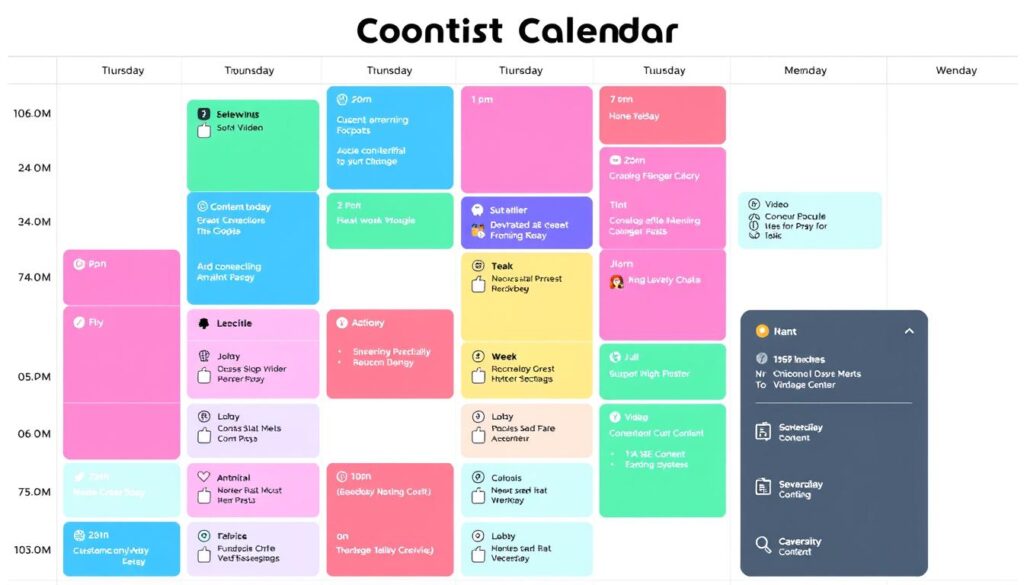In today’s digital world, making great website content is key for businesses. Whether you’re starting fresh or updating your site, your content’s quality and relevance matter a lot. It helps grab your audience’s attention and drive sales.
This guide will show you the 9 key steps to make engaging website content. You’ll learn how to connect with your audience and improve your online image. Plus, you’ll get 5 top tips for writing effective website copy. These include SEO optimization and creating stories that stick with people.
Key Takeaways
- Know your audience and create content that speaks to them
- Make a content plan with clear goals and a variety of content types
- Do keyword research to make your content search-friendly
- Follow a 9-step process to create and share your content
- Use best practices for SEO, user experience, and promoting your content
Understand Your Target Audience
Before you start making your website content, it’s key to know your target audience well. You need to create buyer personas and find out what they struggle with and what they want. This way, you can make your content fit their needs and interests perfectly.
Define Buyer Personas
Buyer personas are like fictional versions of your perfect customers. They’re based on real data from your current clients. To make good buyer personas, look into your audience’s demographics, behaviors, and likes. This helps you make content that really talks to their problems and dreams.
Identify Pain Points and Desires
After you’ve made your buyer personas, it’s time to find out what they struggle with and what they. What problems do they face? What are their goals and what drives them? Knowing this lets you make content that meets their needs and speaks to them deeply.
“The better you understand your target audience, the more effectively you can create content that captivates and converts them.” – Digital Marketing Expert
By spending time on your buyer personas and their pain points and desires, you’re on the right path. You’ll make website content that really connects with your audience and gets them engaged.
Develop a Content Strategy
Creating a solid content strategy is key to making your website content hit the mark with your audience. By setting clear goals and choosing the right content types and formats, you can make sure your content reaches and engages your target market effectively.
Set Clear Goals
The first step is to define your content goals. Think about what you want your content to do. Do you want to attract more visitors, get leads, increase brand awareness, or teach your audience something new? Having specific and achievable goals helps guide your content creation.
Plan Content Types and Formats
Next, decide on the content types and formats that will best meet your audience’s needs and match your goals. Will blog posts, landing pages, videos, or infographics work best? Look at what your target audience likes and needs to find the best mix. A good content plan includes different formats to reach people in various ways.
| Content Type | Content Format | Potential Benefits |
|---|---|---|
| Blog Posts | Long-form articles | Improve search engine visibility, educate audience, establish thought leadership |
| Landing Pages | Sales-focused pages | Generate leads, promote products/services, drive conversions |
| Videos | Explainer videos, interviews, tutorials | Enhance engagement, improve user experience, showcase expertise |
| Infographics | Data visualizations, process overviews | Convey complex information in a visually compelling way, improve shareability |
By aligning your content strategy with clear goals and the right mix of content types and formats, you can create a powerful and effective online presence that resonates with your target audience.
Conduct Keyword Research
Creating content that ranks well starts with keyword research. This step helps find the words your audience uses to find what you offer. Understanding SEO optimization lets you make content that meets your audience’s needs, boosting your online presence.
Start by making a list of terms related to your business. Think about what your ideal customers search for. Use tools like Google Keyword Planner, Semrush, or Ahrefs to find more keywords.
- Analyze search volume and competition for each keyword
- Identify long-tail keywords and related search queries
- Group keywords into themes or topics for content planning
- Prioritize keywords based on relevance, search volume, and competition
Using keyword research in your content strategy attracts the right audience. This improves your SEO optimization and drives more traffic to your site. By making content that speaks to your audience, you increase your online visibility.
“Effective keyword research is the foundation of any successful SEO optimization strategy.” – SEO Strategist, John Doe
| Keyword | Search Volume | Competition | Relevance |
|---|---|---|---|
| keyword research | 2,400 | High | High |
| seo optimization | 1,800 | High | High |
| content optimization | 1,200 | Medium | High |
| search engine marketing | 2,000 | High | High |
By using keyword research insights, you can make content that speaks to your audience. This boosts your SEO optimization and search engine marketing performance.
Create Website Content In 9 Steps
Making great website content is key to keeping your audience interested and meeting your marketing goals. From planning your content calendar to writing catchy headlines, we’ll cover nine essential steps. These steps will help you create content that speaks to your target market.
Step 1: Plan Your Content Calendar
Start with a solid content calendar for effective planning. This tool helps organize your content creation, ensures regular posts, and matches your content with marketing plans. Begin by setting your content goals, knowing your audience, and planning a schedule that fits your business aims.
Step 2: Write Compelling Headlines
Your website’s headlines grab the first glance of visitors. They’re vital for drawing in and keeping interest. Write headlines that are short, clear, and grabby. Use keywords wisely and add a touch of curiosity, benefit, or urgency to spark interest.
| Headline Elements | Examples |
|---|---|
| Curiosity-Driven | “The Surprising Secret to Boosting Website Traffic” |
| Benefit-Focused | “Unlock Your Business’s Full Potential with These 5 Tips” |
| Urgency-Driven | “Don’t Miss Out: Limited-Time Offer Ends Soon” |
By learning these content planning and copywriting tips, you can build a strong content calendar. You’ll also write headlines that grab attention and encourage people to explore your website.

Optimize for SEO
Good search engine optimization (SEO) is key to making your website easy to find. It involves using keywords well in your content and making your meta tags better.
Incorporate Keywords Naturally
When you write your website content, use keywords and phrases that fit naturally. Don’t stuff your content with keywords, as it can hurt your visibility. Do thorough keyword research to find what your audience is looking for. Then, add these keywords smoothly into your text.
Optimize Meta Tags
Meta tags, like the title tag and meta description, are vital for your website’s visibility. Make sure your meta tags match what each page is about. They should also have the right keywords and make people want to visit your site.
| Meta Tag | Purpose | Best Practices |
|---|---|---|
| Title Tag | Displays the title of your web page in search engine results | Keep it concise (up to 60 characters), include your primary keyword, and make it compelling. |
| Meta Description | Provides a brief summary of your web page’s content | Craft a unique, engaging description (up to 160 characters) that includes your target keywords and encourages clicks. |
By using keywords naturally and improving your meta tags, you can make your website more visible. This helps your content get found by your target audience.
Craft Engaging Copy
Making your website content engaging is more than just sharing information. It’s about touching your audience’s emotions and getting them to act. The secret is in brand storytelling and persuasive language.
Tell a Compelling Story
Good copywriting tells a story that speaks to your audience. A strong brand story creates an emotional bond and makes a lasting impact. Use relatable characters, vivid descriptions, and a clear story to grab and keep your readers’ attention.
Use Persuasive Language
Pair your brand story with persuasive language to get your readers to act. Use strong verbs, emotive adjectives, and a friendly tone to enhance content engagement and improve user experience. The right words can inspire and motivate your audience.
| Persuasive Techniques | Examples |
|---|---|
| Rhetorical Questions | “Aren’t you tired of the same old solution?” |
| Repetition | “Discover, Delight, and Deliver with our platform.” |
| Testimonials | “Our customers rave about the ease of use and time-saving features.” |
By becoming skilled in brand storytelling and persuasive language, you can create website content that grabs your audience’s attention. This drives content engagement and meaningful interaction.
Enhance User Experience
It’s key to keep your website visitors interested. We’ll look at how to make your content easy to read and use. This way, your visitors can enjoy and interact with your site easily.
Improve Readability
Content that’s easy to read is vital for a good user experience. Here are some tips to make your content more readable:
- Choose simple, clear language and avoid hard words.
- Split your text into short, easy-to-read paragraphs with lots of space.
- Use catchy headings to help readers follow your content.
- Adjust font size, line spacing, and alignment for better reading.
- Make sure your site works well on all devices for a smooth experience.
By making your content easy to read, you’ll keep your audience interested. Always check your content and make changes based on what your visitors say and do. This will help you keep improving their experience.
| Metric | Baseline | Target |
|---|---|---|
| Flesch Reading Ease | 60 | 70 |
| Flesch-Kincaid Grade Level | 8 | 7 |
By following these tips and keeping an eye on your content’s readability, you’ll create a great user experience. This will help your website succeed. To learn more about using AI for better SEO content, read this article: How to Power Your SEO Content with AI in 5.
Incorporate Visuals
Visuals are key to making your website content stand out. High-quality images and videos grab your audience’s attention. They make your content more engaging and shareable.
Use High-Quality Images and Videos
Visuals are a strong tool for sharing information and stirring emotions. Choose images and videos that are clear, bright, and eye-catching. Stay away from low-quality or generic images that can harm your site’s look.
Think about how visual content can support your written content. Use images and videos to add variety and highlight important points. Try out different multimedia like infographics or animated GIFs to boost your site’s look.
“A picture is worth a thousand words. The right visual can make all the difference in captivating your audience and leaving a lasting impression.”
Using visual content well can really boost content engagement. It makes your site more memorable. By mixing text and visuals well, you can create a site that really connects with your audience.

Website Copywriting Best Practices
To make your website content effective, follow website copywriting best practices. It’s vital to keep your content short and easy to scan. Today, people have short attention spans. They like content they can quickly read and understand.
Keep It Concise and Scannable
Creating concise and scannable content is crucial. It keeps your audience engaged and improves their experience. Here are some tips:
- Write short, impactful sentences and paragraphs. Aim for 20-25 words per sentence and 3-4 sentences per paragraph.
- Use clear headings and subheadings to help readers find what they need.
- Present information in bullet points and numbered lists for a structured format.
- Add whitespace to make your content stand out in a clean layout.
- Use bold, italics, and other formatting to draw attention to important points.
By following these tips, you can make your content scannable and engaging. This will help your audience connect with your website and enjoy their visit.
“Concise and scannable content is the hallmark of a user-friendly website. It helps your audience quickly find the information they need and boosts their overall satisfaction with your online presence.”
Promote and Repurpose Content
Creating great website content is just the start. To really make an impact, you need to promote and repurpose it. Use social media, email marketing, and content distribution to spread your message. This guide will show you how to get your content seen by more people.
Amplify Your Reach through Promotion
Promoting your content is key to getting more views and interactions. Here are some ways to share your work:
- Post your content on social media platforms like LinkedIn, Twitter, and Facebook. Use the right hashtags and talk to your followers.
- Send your content via email marketing to your subscribers. Make your emails personal and include a clear call-to-action.
- Look for guest posting spots on blogs and websites in your field. It’s a great way to meet new people and show off your skills.
- Join online communities and forums that match your niche. Share your knowledge and link back to your content.
Extend Your Content’s Lifespan through Repurposing
Don’t let your hard work disappear. Turn your content into different formats to make it last longer:
- Make blog posts into social media graphics or short videos for easy sharing.
- Put together related articles into a comprehensive e-book or whitepaper.
- Change written content into podcasts or webinars for different learning styles.
- Break down long content into bite-sized snippets for email newsletters or social media updates.
By using both content promotion and content repurposing, you can make your content reach more people. This will help drive more traffic, engagement, and conversions.
Measure and Analyze Results
It’s key to keep an eye on how your website content is doing. By looking at engagement metrics, you can see what’s working and what’s not. This helps you make your content strategy better and improve your content performance with data.
Track Engagement Metrics
To see how well your website content is doing, watch these engagement metrics:
- Pageviews: How many times a page is seen
- Time on Page: How long users stay on a page
- Bounce Rate: How many users leave after seeing just one page
- Conversion Rate: How many users do what you want them to, like buy something
- Social Shares: How many times your content is shared online
Refine Your Strategy
Looking at these content analytics helps you see what content your audience likes. This lets you make smart choices to improve your content strategy. It’s all about using data to make your content better.
- Find out what content works well and do more of it
- See what content isn’t doing well and fix it
- Learn what your audience likes and make content for them
- Use your resources wisely to make content that gets the best engagement metrics
- Keep making your content better to meet your audience’s needs
By using data to guide you, you can make sure your website content stays relevant and useful. This way, you keep your audience engaged and interested.
Conclusion
Making great website content is a detailed task that needs careful planning and execution. By following the 9 essential steps and 5 best practices in this guide, you’re on the right path. You’ll create a strong and engaging online presence that attracts your audience and brings real results for your business.
Understanding your audience and planning a content strategy are key. So is optimizing for search engines and improving user experience. Each step is important for making your website content better. Using digital and content marketing, you can build a lasting online presence that makes your business stand out.
The journey to create top-notch website content never ends. Keep measuring, analyzing, and improving your strategy. This way, your content will stay fresh, interesting, and effective for your audience. With hard work and a focus on quality, you can achieve great things with your website content and see amazing results for your business.


